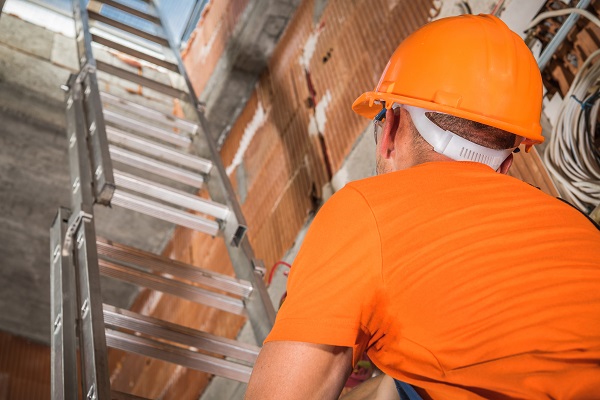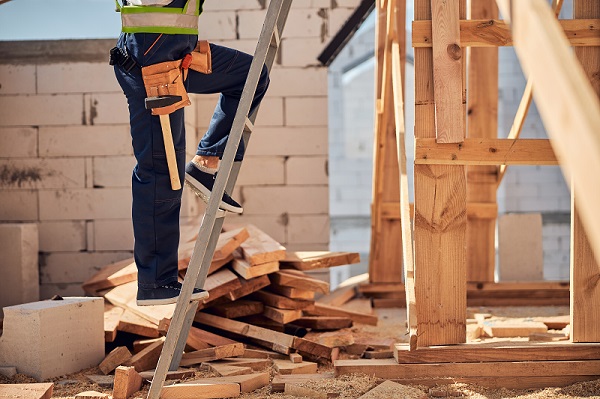When something is used frequently in the workplace, it’s easy to become complacent towards its hazards – but hazards exist and need to be consciously prevented, and that’s why companies need to implement the OSHA ladder safety rules.
During everyday workplace activities, ladder safety is vital for personal fall protection and to avoid other ladder-related injuries. In 2020, the highest cited OSHA violation was fall protection, with ladder safety violations as fifth most cited.
Ladders can be portable or fixed, and each type of ladder comes with its own rules and fall protection systems.
Ladder safety violations can be costly if your workplace undergoes an OSHA inspection, so to avoid the penalties and fees, here’s everything you need to know about OSHA ladder safety.

How to Choose the Correct Ladder for the Circumstances
There are numerous types of portable ladders, each made for a particular job. Each ladder has a label stipulating the circumstances it was made to be used for, as well as its maximum intended load (also known as duty rating).
When choosing the correct ladder, the things to consider are:
- ladder type,
- ladder height, and
- ladder maximum intended load.
Using the wrong portable ladders could result in accidents or injury. For example, workers should never use metal ladders for electrical work on energized electrical equipment. Wooden ladders or a plastic ladder reduce electrical hazards.
Using an incorrect ladder could result in additional OSHA ladder safety violations. For example, if a ladder is too short, workers might place it on top of something else to increase its height. This is hazardous because it increases the chances of slipping or falling.
What Are the Safety Rules for Different Types of Portable Ladders?
Below are some examples of common ladder types seen in the workplace. Take note that every ladder comes with its own instructions and warning labels that need to be adhered to for OSHA ladder safety compliance.
Step stools provide a small amount of height to reach something overhead. Therefore, they must be sturdy and able to support the intended weight. If the step stool is higher than 24 inches, it must have side rails.
Self-supporting ladders range from 6 to 30 feet high. They are generally A-shaped and must be able to support themselves. In addition, the ladder’s locking device must be locked in place before the ladder is used.
A straight ladder is leaned against a structure for a worker to gain access to an upper level. These portable ladders can be 10 to 30 feet high and must be three feet higher than the height of the structure they’re leaning on. In addition, they must be positioned to lean at a 75-degree angle.
An extension ladder can extend at least 60 feet high. These portable ladders consist of a straight ladder with an extension section attached. An extension ladder must also be leaned at a 75-degree angle three feet higher than the height of the structure they’re leaning on.
Rolling ladders have side rails and handrails because the caster wheels can swivel in any direction. Therefore, workers must set the foot-operated safety lock on the wheels before use.

What Are the Safety Rules for Different Types of Fixed Ladders?
Fixed ladders are permanently attached to a building structure or piece of equipment.
Fixed ladders have different rules and regulations depending on when they were made. However, OSHA gives clear guidelines for fixed ladders installed before and after October 1983 in Standard Number 1917.118.
A fixed ladder higher than 20 feet must have a cage, well, or safety device for fall protection.
Cage: this is a barrier attached to the ladder’s side rails or another structure that encloses the fixed ladder’s climbing space.
Well: a permanent enclosure around the ladder that’s attached to the walls.
Ladder safety device: lifelines or sliding attachments that limit the worker’s drop should they fall from a fixed ladder.
What Are The General Ladder Safety Rules?
While each type of ladder has its own rules to ensure safety and fall protection, there are some general OSHA rules regarding portable ladder safety.
- Before using a ladder, workers must inspect for visible defects. If any are present, the ladder should be removed from service and repaired.
- The ladder rungs, cleats or steps must be parallel, straight, and uniformly spaced. They must also be made from appropriate material for slip-resistant feet positioning.
- Workers must operate a portable ladder on stable and level surfaces only. Unsecure ladders require stabilization.
- Workers must face inwards towards the ladder rungs and keep at least one hand on the ladder at all times when climbing up or down. No object or load may be carried if it presents the risk of the worker losing balance.
- The top step of a ladder mustn’t be sat, stood or climbed on except if the ladder has a platform and side rails.
- All ladders must have safety labels.

How Can Insure Compliance Help Your Company With Ladder Safety?
At Insure Compliance, we help companies with hazard analysis, policies, training, inspections and accountability programs.
We do this using our unique Safety Gap Model that assesses the safety gaps in your company – and then we help you bridge those gaps.
The safety gaps focus on the:
- awareness gap: knowing what the company’s responsibilities are regarding ladder safety,
- process gap: documenting ladder safety policies in the employee handbook,
- knowledge gap: providing training with employees on ladder safety policies,
- verification gap: regularly inspecting the workplace to ensure compliance with the policies, and
- accountability gap: following the appropriate disciplinary procedures for employee ladder safety violations.
We offer training for all employees and employers to meet OSHA ladder safety requirements, including:
- the fall hazards associated with ladders and how to recognize them,
- putting procedures into place to minimize fall hazards,
- when and how to use fall protection systems,
- fixed and portable ladder rules,
- inspection of ladders, and
- maintenance of ladders and systems of fall protection.
Key Takeaways
Reaching an elevated point in the workplace isn’t as simple as grabbing the nearest ladder and going ahead.
Using the incorrect ladder for an inappropriate circumstance can compromise workers’ safety and health and lead to falls, accidents, and even fatalities.
Each type of ladder has been specifically designed for a particular purpose, and each, therefore, comes with its own rules for use.
Additionally, general safety rules apply to all portable and fixed ladders that need to be adhered to.
To address any safety gaps in your company, and provide adequate ladder safety training to your workers, contact Insure Compliance today. We can help you bridge those gaps and reach OSHA compliance.
Disclaimer:
Please note that every effort has been made to ensure that the information provided in this guide is accurate. You should note, however, that the information is intended as a guide only, providing an overview of general information available to businesses. This guide is not intended to be an exhaustive source of information and should not be seen to constitute legal, safety or business advice. You should, where necessary, seek your own advice for any issues raised in your affairs.








2 Responses